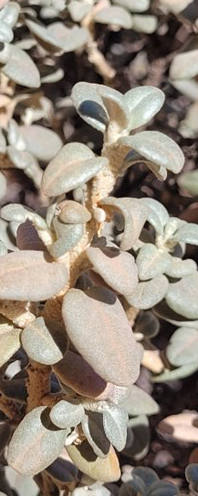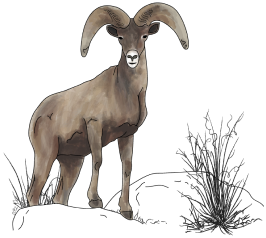Shepherdia rotundifolia Parry
Eukaryota > Viridiplantae > Streptophyta > Streptophytina > Embryophyta > Tracheophyta > Euphyllophyta > Spermatophyta > Magnoliopsida > Mesangiospermae > eudicotyledons > Gunneridae > Pentapetalae > rosids > fabids > Rosales > Elaeagnaceae > Shepherdia > Shepherdia rotundifolia [1]

Image of the leaves and stem of Shepherdia rotundifolia. Photo by Kylee Larsen.
Shrub 1-2 m tall with branchlets stellate-hairy with white or yellowish trichomes. Leaves opposite, 0.5-4.2 cm long, 5-38 mm wide, ovate, oval, orbicular, or lanceolate; apex rounded, base rounded to obtuse, silvery green above, pale below, clothed with trichomes. Flowers axillary, 1 to few per node, 3.5-5 mm long, the lobes yellowish, open, flat. Fruits 5-8 mm long, the surface obscured by silvery scales, ellipsoid, stellate-hairy [2].
![Habit of Shepherdia rotundifolia at Pine Creek in Zion NP, Utah, USA [9].](/crfs/images/native-plants/plant-directory/roundleafbuffalo-sec.jpg)
Habit of Shepherdia rotundifolia at Pine Creek in Zion NP, Utah, USA [9].
Shepherdia rotundifolia can be distinguished from other Shepherdia species in Utah by its silvery, scaled fruits and evergreen leaves, whereas S. argentea and S. canadensis have red fruits and deciduous leaves [2].
Shepherdia rotundifolia was first collected and described from the Upper reaches of the Virgin River in southern Utah by Dr. Charles C. Parry in 1873 who was a British-American medical doctor, botanist, and mountaineer. Dr. Parry discovered and described numerous plant species from Utah, Colorado, and surrounding areas as a result of his expeditions and explorations [3]. The specific epithet rotundifolia means round leaf, in reference to its rounded, oval shaped leaves.
![Flowers and stellate hairs of Shepherdia rotundifolia in Grand Canyon National Park. Photo by Matt Lavin [10].](/crfs/images/native-plants/plant-directory/roundleafbuffaloberry-third.jpg)
Flowers and stellate hairs of Shepherdia rotundifolia in Grand Canyon National Park. Photo by Matt Lavin [10].
Like other species of Shepherdia, roundleaf buffaloberry is a nitrogen fixer and thus has been used on sites undergoing reclamation to add nitrogen to the soil [4]. The Navajo make a lotion of ashes to soothe headaches, toothaches, and sore throats, and to heal a baby’s navel [5].
Other species of Shepherdia produce sweet, red berries that are eaten raw or cooked by many Native American tribes in soups, jellies, and other preparations, and are a critical component of pemmican, a dried meat and fat staple for winter months [6]. However, Shepherdia rotundifolia berries are said to start out sweet when chewed but turn quite bitter as an aftertaste, and are thus rarely eaten. All species of Shepherdia contain saponins, chemicals that foam when whipped with water. They are used by Native Americans to create “Indian Ice Cream” by whipping the berries with sugar and hot water to produce a foamy, meringue-like desert [6]. Saponins provide protection against fungi, bacteria, and insect herbivory and thus used to help preserve pemmican [6]. The foaming action of the saponins acts as a natural soap and gives the genus another of its common names: soapberry.
![[Native distribution of Shepherdia rotundifolia at a county level [7].](/crfs/images/native-plants/plant-directory/roundbuffaloberry-fourth.jpg)
Native distribution of Shepherdia rotundifolia at a county level [7].
Shepherdia rotundifolia was last assessed for NatureServe status on 30 June 1993. It is listed as vulnerable in Utah and imperiled in Arizona [8]. It has not been assessed for the IUCN Red List.
Shepherdia rotundifolia is found on steep, rocky slopes, nutrient poor soils, and drier canyon habitats in Blackbrush, ephedra, rabbitbrush, shadscale, pinyon-juniper, and ponderosa pine communities at 4,000-8,500 ft (1219-2591 m) elevation [2]. It flowers from March to June.
[1] "Taxonomy Browser (Shepherdia rotundifolia)." National Center for Biotechnology Information, https://www.ncbi.nlm.nih.gov/Taxonomy/Browser/wwwtax.cgi?id=36904
[2] Welsh, S. L. 2003. A Utah flora. 3rd ed., Brigham Young University Press. ISBN 0-8425-2556-4
[3] s.n. 1890. “Dr. Charles C. Parry.” Botanical Gazette 15(3): 66-68.
[4]SEINet Portal. “Shepherdia rotundiolia” https://swbiodiversity.org/seinet/taxa/index.php?tid=265#
[5] Moerman, Daniel E. 1998. Native American Ethnobotany. Timber Press, Oregon.
[6] Mitton J. 2016. “Roundleaf buffaloberry is a bitter pemmican ingrediant” Colorado Arts and Sciences Magazine 16 June 2016.
[7] USDA NRCS National Plant Data Team. "Shepherdia rotundifolia Plant Profile." USDA Plants Database, https://plants.usda.gov/home/plantProfile?symbol=SHRO
[8] "Shepherdia rotundifolia - roundleaf buffaloberry." NatureServe Explorer 2.0, https://explorer.natureserve.org/Taxon/ELEMENT_GLOBAL.2.153881/Shepherdia_rotundifolia
[9] https://commons.wikimedia.org/wiki/File:Shepherdia_rotundifolia_kz03.jpg
[10] https://www.flickr.com/photos/plant_diversity/8003262498/



